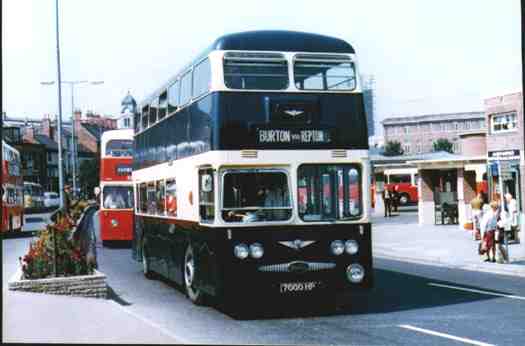
DERBY FLEETLINES.
1966 - 2008
An Appreciation of 42 years serving Derby
The first Daimler Fleetline appeared on the streets of Derby in 1966. It would be an incredible 42 years later before the final example (4301 - GTO 301V) ended its service days in Derby albeit having been restricted to school journeys during school term only. The Derby Corporation Omnibus Department and Derby City Transport are now gone, swallowed up by a corporate national conglomerate known as 'Arriva'. By January 2004 the 'legal lettering' on the vehicles gives a Leicester address thus finally removing any form of local connection.
The Fleetline was a revolutionary vehicle at the time of its introduction. A rear tranverse mounted engine with a fluid coupling linking it to the gearbox provided power to the drop centre rear axle by means of an ingenious angle drive. This layout allowed low height bodywork retaining central gangways on both decks and a front entrance. The majority of Fleetlines were supplied with the legendary Gardner 6LX and later 6LXB engines. Leyland took a controlling interest in 1968 and from 1970 their 680 engine became an option. This was the beginning of the end for the Fleetline. By the end of 1974 the chassis became known as the Leyland Fleetline and production (now at Leyland) ended in 1980 with 11728 chassis being built basically to 30 foot or 33 foot double deck and the same lengths for single decks.
The very first Fleetline went to Blue Bus Services of Willington, near Derby, after use as a demonstration vehicle. This respected Company were taken over by Derby Corporation in 1973. On 5th January 1976 the Willington garage was destroyed by fire, along with several unique vehicles the prototype Fleetline was lost. The vehicle is seen on The Morledge in Derby (below).
Courtesy Arnold Richardson/Photobus.

The first Fleetline (numerically) in Derby's fleet was 172 (HRC 172C). The bodywork is by Charles Roe of Leeds. Derby had a long association with Roe who bodied all of their Daimler CVG6 vehicles as well as the last trolleybuses. 172 is seen in the Market Place during 1982. The vehicle was exported to Canada for use on tours of Niagra Falls.

After 172-4 (HRC xxxC) the next batch of Fleetlines were 175 - 184 (KRC xxxD), with these came the final CVG6 half cab vehicles (185 - 189). 177 (KRC 177D) is seen in the Market Place in 1982. The vehicle had won an unexpected reprieve and had been treated to a repaint.

More Fleetlines, still with the same style of Roe body arrived over the next couple of years in the form of 190 - 204 (NCH xxxE), 205 - 219 (UCH xxxG), 220 - 239 (XCH 4xxG). 205 - 219 were the last vehicles delivered in the very attractive Green/Cream livery. The Blue/Grey had been introduced to indicate the vehicle was one man operated rather than conductor operated; this was then adopted as standard livery. 210 (UCH 210G) is seen (below) in Green/Cream livery.
Courtesy Arnold Richardson/Photobus.
